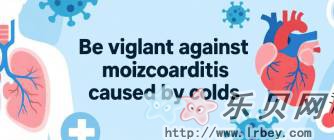|

About 5% of viral infections can cause myocarditis!
It is easy to catch a cold all year round. Although the cold disease is small, once it causes myocarditis, it should be taken seriously, especially for children under 5 years old. If left untreated, it can also endanger their lives.
According to statistics, myocarditis is more common in children aged 3-10 years old after catching a cold. This is because children's immune function is not yet perfect, and they are easily invaded by various bacteria and viruses. Viruses can directly invade the heart muscle, or it may be caused by autoimmune reactions after viral infection. The former is more common in children, while the latter is more common in teenagers.
The severity of viral myocarditis varies, and its characteristics can be summarized as "one large, one small, and one fast". 'One major' refers to the significant difference in the severity of the condition. Mild cases may have no symptoms, while some children may only show changes in their electrocardiogram. Typical symptoms include mental fatigue, pale complexion, fatigue, laziness, excessive sweating, nausea, vomiting, upper abdominal pain, etc. Older children may self-report palpitations, dizziness, palpitations, chest tightness, shortness of breath, discomfort or pain in the precordial area. 'Yi Shao' refers to the absence of clinical symptoms, which means that the symptoms of the child are relatively simple, such as some children only showing signs of laziness. Rapid changes in the condition can lead to diffuse heart enlargement and heart failure in a short period of time; Some cases of arrhythmia can lead to repeated fainting and even sudden death.
A young child cannot accurately express their condition, and parents must observe carefully, especially if the child develops shortness of breath, laziness, and excessive sweating after catching a cold. It is best to go to the hospital for necessary examinations such as myocardial enzymes, cardiac troponin, electrocardiogram, etc.
Mild myocarditis is difficult to detect early and mainly relies on clinical diagnosis by doctors. The clinical diagnostic criteria for viral myocarditis established in China mainly include four aspects: 1. Cardiac dysfunction, cardiogenic shock, or cardiovascular and cerebrovascular syndrome. 2. Cardiac enlargement (one of the manifestations of X-ray and echocardiography examination). 3. There are changes in the electrocardiogram. 4. Elevated CK-MB or positive cardiac troponin I or cTnT. Children must have both of the above diagnostic criteria in order to be clinically diagnosed with viral myocarditis.
However, due to the very strict diagnostic criteria, the author found that some children with viral myocarditis only meet one of these criteria, and they have learned the lesson of dying due to not receiving timely treatment. Therefore, many doctors believe that as long as one of the symptoms is present, it should be followed up as a "suspected myocarditis" to prevent delaying the condition.
Not paying attention to rest and engaging in vigorous exercise after catching a viral cold can easily lead to myocarditis. So whether it's preventing myocarditis or not, adequate rest is crucial. Once diagnosed with myocarditis, absolute bed rest for at least 3 months is necessary. If there are no symptoms in the future, work and normal study can be gradually resumed, and physical labor and exercise should not be engaged in for one year. In addition, it is necessary to ensure nutritional balance and eat more fresh vegetables and fruits. Ensure sufficient sleep and avoid catching a cold, as repeated attacks can lead to chronic myocarditis and cardiomyopathy, which can cause lifelong harm.
In summary, it is emphasized once again that:
1. Pay attention to rest after catching a cold, do not work or even participate in vigorous exercise while sick. In the case of fatigue and weakened immunity, the cold virus may take advantage of the situation and invade the heart muscle.
2.If discomfort symptoms such as palpitations, chest tightness, shortness of breath, fatigue, dizziness, and shortness of breath occur 1-3 weeks after catching a cold, one should be alert to the possibility of myocarditis and seek early diagnosis and treatment.
3. People with a history of heart disease and the elderly should receive the flu vaccine during the flu season to prevent the flu and reduce the threat of cardiovascular disease.
4. To prevent catching a cold again after suffering from myocarditis, choose vitamin C, coenzyme Q10 tablets, Qishen Yiqi Dripping Pills, vitamin E, etc. Traditional Chinese medicine can be used to treat myocarditis, such as myocarditis rehabilitation soup and myocarditis nourishing powder.
|